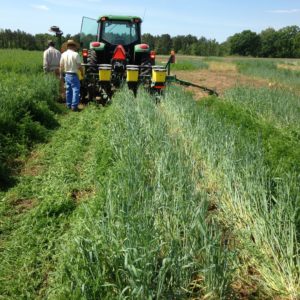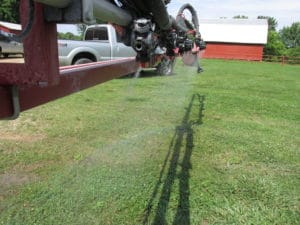In this short video, Dr. Larry Steckel discusses factors to consider before making burndown applications this spring.
Recent Updates
Tennessee Cotton Acreage Continues to Rebound After Record Low in 2015
Released: March 31, 2017
Tennessee Cotton Acreage Continues to Rebound After Record Low in 2015
NASHVILLE, Tenn. – The U.S. Department of Agriculture’s National Agricultural Statistics Service (NASS) released the Planting Intentions report today, showing Tennessee farmers intend to plant less corn, but more soybeans this year.
“Prospective plantings gives us the first indication of producer’s plans for row crop acreages,” said Debra Kenerson, Tennessee State Statistician. “In addition to farmers intending to plant 90,000 more soybean acres, this release indicates that cotton acreage is on a slow but steady increase from the record low acreage in 2015.”
Farmers in Tennessee intend to plant 840,000 acres of corn, 40,000 acres lower than 2016. U.S. corn growers intend to plant 90 million acres for all purposes in 2017, down four percent from last year and two percent higher than 2015. Continue reading at MarchPP17_TN.
Tennnessee Variety Test Program Survey
Things have been busy this past month in the Tennessee variety test program as entries continue to roll in for our 2017 corn and soybean tests. This year we will be testing a total of 86 corn grain hybrids, 11 corn silage hybrids, and 195 soybean varieties across the state of Tennessee.
We know the variety test program is important to many of you. In order to make sure this program continues to meet your needs, we’d like some feedback from you!
If you are a Tennessee corn, soybean, wheat, or cotton producer, please take a few minutes to help us out by taking this survey. Producer – Variety Test Survey
If you are not a producer, but you provide folks with advice on variety selection (scout, retailer, seed company rep), then please take this survey. Industry – Variety Test Survey
Thanks for your help as we continue to figure out ways we can better serve you through our Tennessee variety test program!
Weed Control with your Cover Crop
 With planting just around the corner, there are a few management considerations of cover crops that are being used for weed control. There is no single best way to manage all cover crops prior to any given cash crop. Tailoring the cover crop to best fit your cash crop can make a difference in the ultimate success of your weed control program. Continue reading
With planting just around the corner, there are a few management considerations of cover crops that are being used for weed control. There is no single best way to manage all cover crops prior to any given cash crop. Tailoring the cover crop to best fit your cash crop can make a difference in the ultimate success of your weed control program. Continue reading
Plant bugs are off to an even earlier start
Tarnished plant bugs are the #1 insect pest of cotton in Tennessee. In the fall of the year, tarnished plant bug (TPB) nymphs develop into adults on weedy hosts, and these adults overwinter on these hosts or plant debris. Previous studies have found that overwintered populations of tarnished plant bugs emerge from diapause in late winter or early spring, triggered by a combination of cues including a good food source and warm temperatures. Continue reading
New Nozzles with the New Technology
 With the Xtend technology now available, hopefully everybody is gearing up with the correct nozzles and application knowledge needed to be successful. Although there are other application requirements in place with the new Xtendimax™ (www.xtendimaxapplicationrequirements.com) and Engenia™ (www.engeniatankmix.com) herbicide labels, the single most important thing you can do to steward this technology is equip your sprayer with the correct nozzles. Continue reading
With the Xtend technology now available, hopefully everybody is gearing up with the correct nozzles and application knowledge needed to be successful. Although there are other application requirements in place with the new Xtendimax™ (www.xtendimaxapplicationrequirements.com) and Engenia™ (www.engeniatankmix.com) herbicide labels, the single most important thing you can do to steward this technology is equip your sprayer with the correct nozzles. Continue reading
Wheat Freeze Damage Update, Management and Haylage
Dr. Tyson Raper and Dr. Gary Bates
Reports of no freeze damage received early last week (3/20) were replaced with reports of slight to severe freeze damage by the end of the week (3/24). This article describes how to determine damage, what types of damage have been noted, and management of freeze damage wheat. Continue reading
Wheat Herbicide & Replant Decisions
Video message from Dr. Larry Steckel regarding considerations for wheat replant.


